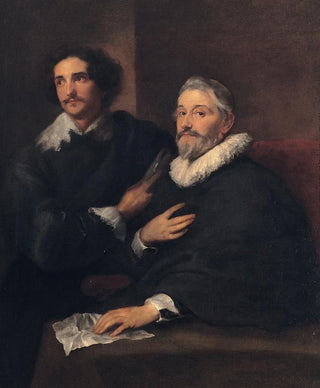Art print | Portrait of the engravers Pieter De Jode the Elder and Pieter De Jode the Younger - Anthony van Dyck


View from behind

Frame (optional)
Portrait Art print of engravers Pieter De Jode l'Ancien and Pieter De Jode the Younger - Antoine van Dyck – Captivating Introduction
In the world of baroque art, few works manage to capture the very essence of an artist's personality and talent like the art print of engravers Pieter De Jode l'Ancien and Pieter De Jode the Younger by Antoine van Dyck. This piece, which transcends a simple portrait to become a vibrant homage to the art of engraving, invites viewers to engage in a visual dialogue between the artist and their models. Van Dyck, master of light and color, manages to breathe palpable life into his subjects, making this work not only a testament to their existence but also a reflection of their contribution to art history.
Style and uniqueness of the work
Antoine van Dyck's style is emblematic of Flemish baroque, characterized by a richness of colors and a depth of field that give the portraits an almost sculptural dimension. In this piece, the composition is carefully balanced, each figure occupying a precise place that enhances the overall harmony. The expressions of the engravers, both serious and contemplative, reflect their dedication to their art. The meticulous details of clothing, textures, and accessories are all elements that reveal Van Dyck's virtuosity. Every brushstroke seems charged with meaning, with each shadow and light skillfully orchestrated to create an atmosphere of intimacy and mutual respect between the artist and their models. This portrait thus becomes an exploration of artistic identity, a celebration of engraving, and a tribute to those who practice it.
The artist and his influence
Antoine van Dyck, a pupil of Rubens, established himself as one of the greatest portraitists of his time. His influence extends far beyond the borders of Flanders, impacting generations of artists across Europe. By choosing to depict Pieter De Jode l'Ancien and his son, Van Dyck not only pays homage to two important figures in engraving but also emphasizes the importance of knowledge transmission and tradition in the art world.

Matte finish

View from behind

Frame (optional)
Portrait Art print of engravers Pieter De Jode l'Ancien and Pieter De Jode the Younger - Antoine van Dyck – Captivating Introduction
In the world of baroque art, few works manage to capture the very essence of an artist's personality and talent like the art print of engravers Pieter De Jode l'Ancien and Pieter De Jode the Younger by Antoine van Dyck. This piece, which transcends a simple portrait to become a vibrant homage to the art of engraving, invites viewers to engage in a visual dialogue between the artist and their models. Van Dyck, master of light and color, manages to breathe palpable life into his subjects, making this work not only a testament to their existence but also a reflection of their contribution to art history.
Style and uniqueness of the work
Antoine van Dyck's style is emblematic of Flemish baroque, characterized by a richness of colors and a depth of field that give the portraits an almost sculptural dimension. In this piece, the composition is carefully balanced, each figure occupying a precise place that enhances the overall harmony. The expressions of the engravers, both serious and contemplative, reflect their dedication to their art. The meticulous details of clothing, textures, and accessories are all elements that reveal Van Dyck's virtuosity. Every brushstroke seems charged with meaning, with each shadow and light skillfully orchestrated to create an atmosphere of intimacy and mutual respect between the artist and their models. This portrait thus becomes an exploration of artistic identity, a celebration of engraving, and a tribute to those who practice it.
The artist and his influence
Antoine van Dyck, a pupil of Rubens, established himself as one of the greatest portraitists of his time. His influence extends far beyond the borders of Flanders, impacting generations of artists across Europe. By choosing to depict Pieter De Jode l'Ancien and his son, Van Dyck not only pays homage to two important figures in engraving but also emphasizes the importance of knowledge transmission and tradition in the art world.






